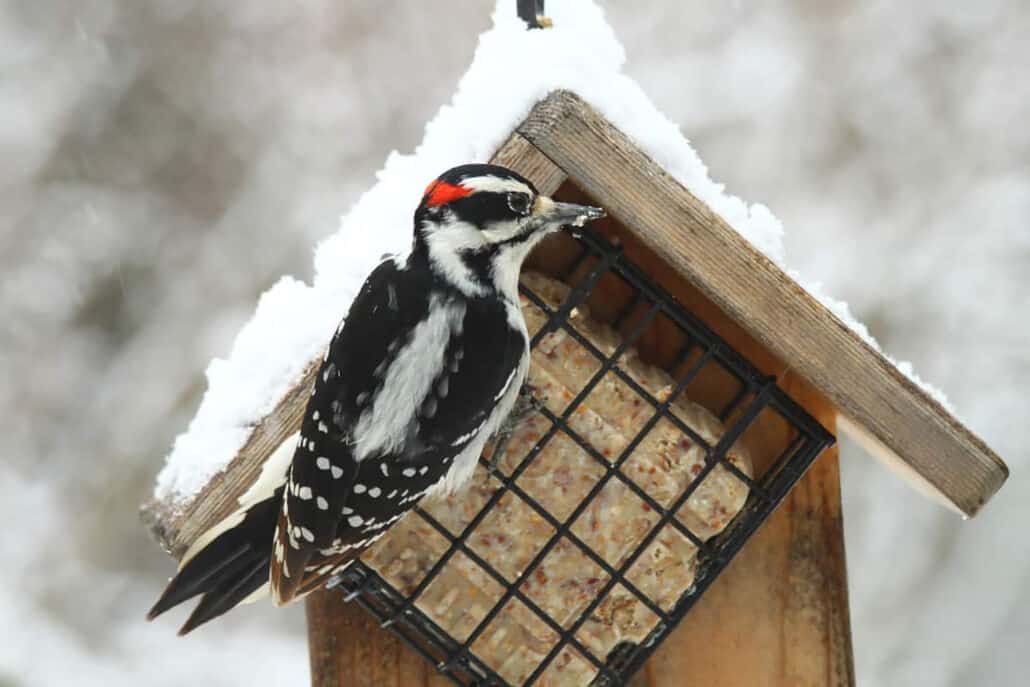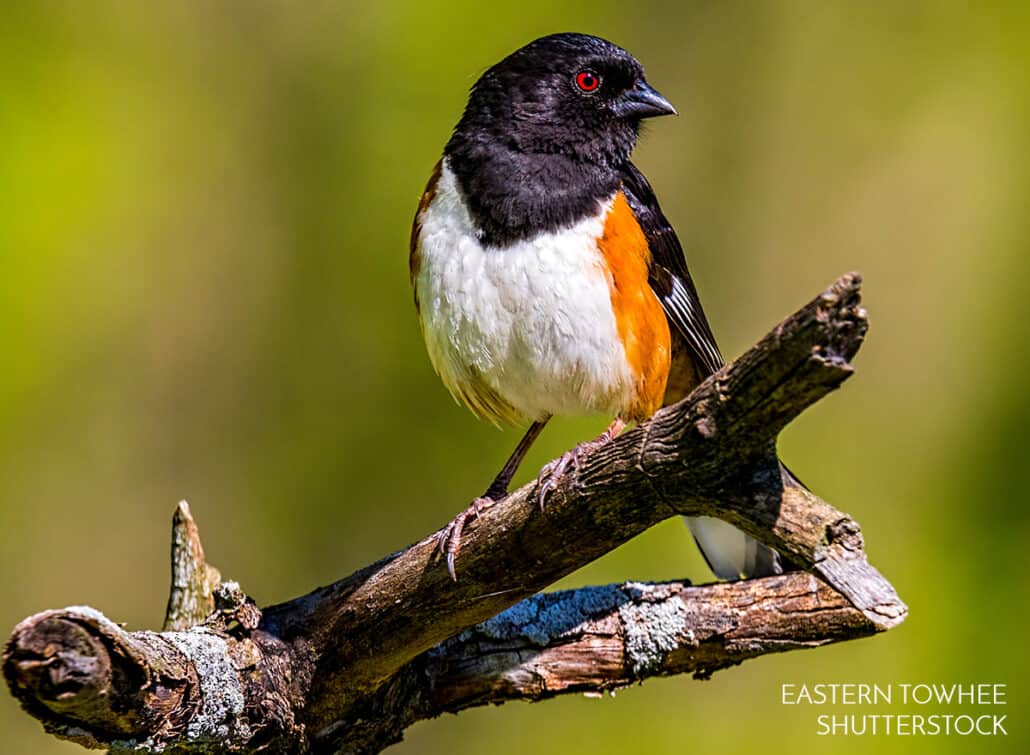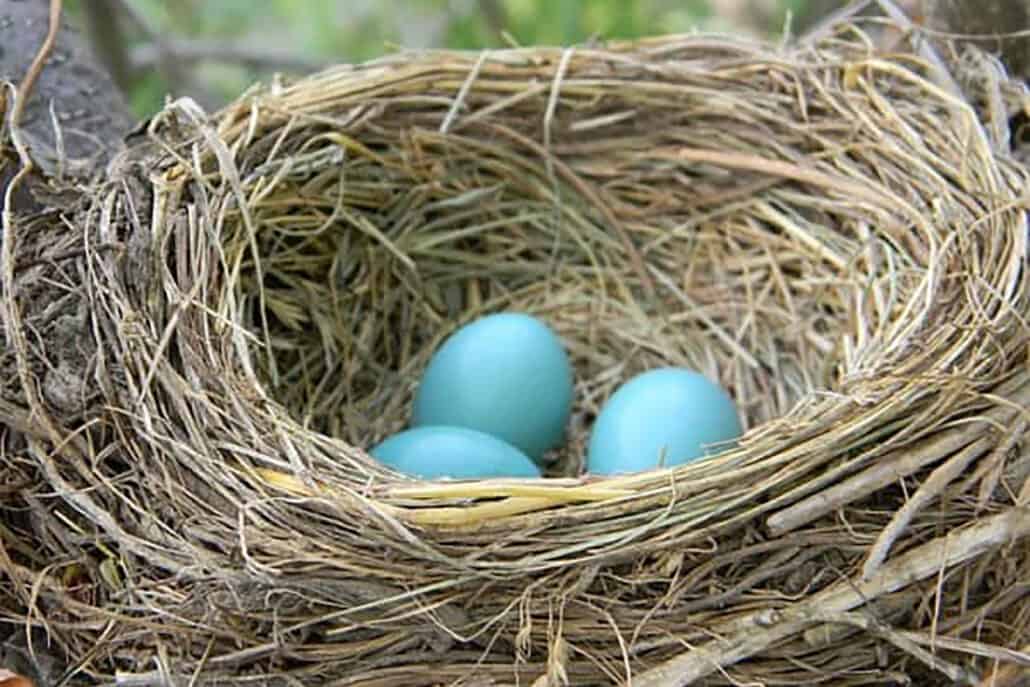Suet
Suet is number one on most woodpeckers’ list of preferred foods offered by humans. Suet is dense, hard, white beef fat. It can be offered raw in small chunks, but it is most conveniently purchased in square blocks, shaped to fit in metal cages or dispensers. Beware of commercial suet cakes that contain seeds in the shell and other filler.
The shells of sunflower seeds that have been dropped into hot, liquid suet become soggy and unsuitable for birds. Suet cakes that contain mealworms, sunflower hearts, nut meats, and dried fruit—or plain suet—are fine. Commercial suet cakes are made of rendered (melted) suet, which has a longer shelf life than raw suet.
You can also make your own suet cakes. Raw suet can usually be found in the meat department of grocery stores, but meat-packing plants usually offer it at a lower price and in larger quantities. You can render raw suet in the microwave, melting it to a liquid state, then pouring it into ice cube molds and freezing it. This makes it slower to melt in hot weather.
Suet is best offered in cage-like feeders, which will prevent birds from hauling away the entire chunk at once. You can make a suet cage yourself from a folded piece of hardware cloth or purchase epoxy-coated wire cages made especially for suet. These can be wired to a tree trunk or suspended from hooks or tree branches, where they are less likely to be robbed by raccoons at night. When the ’coons really get going in mid-spring we’re forced to take even our suspended feeders into the house every night.
A word of caution on suet-feeding: As the weather warms, suet, improperly fed, can do more harm than good to woodpeckers. If it’s offered in a large chunk, woodpecker feathers can easily come into contact with it as they cling to the feeder, and melting suet can foul their plumage. When woodpeckers, especially downies, feed large quantities of suet to their young, it can clog the follicles and cause the feathers to fall out on their faces, all the way up around their eyes.
Here’s how to avoid such problems. If you choose to offer suet in summer, offer only very small chunks that will be consumed in a day or two. Downsize your suet feeder, so the woodpeckers’ breast, belly, and tail feathers won’t contact large chunks of melting suet. You might consider crumbling it into a shallow dish on your deck railing or platform feeder, so they can pick and choose pieces without clinging.
Some people take their suet feeder in every night, pop it in a plastic bag, and put it in the freezer. This helps preserve the fat and has the added bonus of keeping the food away from raccoons. Commercial suet doughs that contain peanut butter and cornmeal (no-melt suets) are much less greasy and less likely to melt in the heat.
An alternative to commercial suet is Zick Dough, which uses lard and peanut butter. See my recipe.
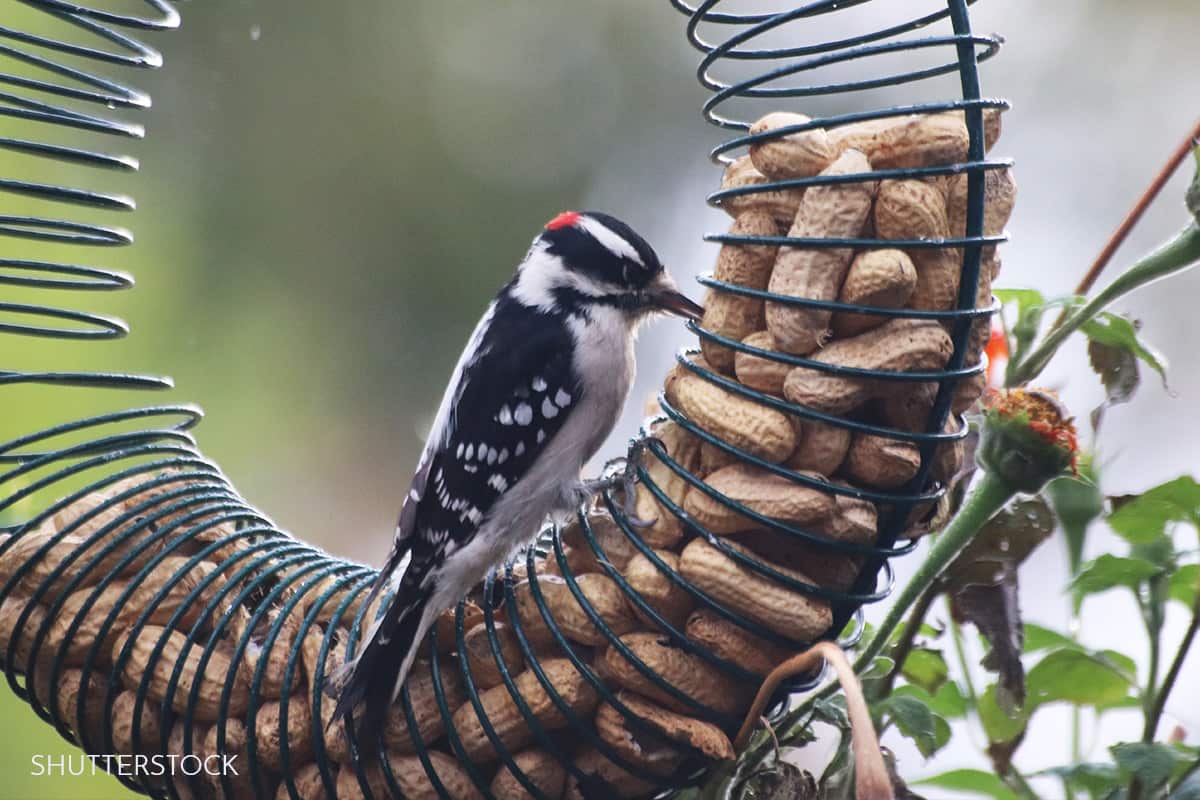
Peanuts
Bulk, raw, unsalted peanuts are a wonderful, fat-rich calorie source for birds year-round. Downy, hairy, and red-bellied woodpeckers find them irresistible, and lucky folks who have red-headed woodpeckers and sapsuckers at their feeders will see lots of action around the peanuts.
Peanut feeders are cylinders of stainless steel square-mesh wire, capped by a heavy base and lid, and they’re perfect for clinging woodpeckers, as well as titmice, chickadees, and nuthatches. Taking the woodpeckers’ cue, jays, goldfinches, cardinals, nuthatches, siskins, and even chipping and field sparrows vie for space on the peanut feeders.
As with other fat-rich foods, some care is in order when feeding peanuts in hot weather. Watch them closely, and as the weather warms, decrease the number of peanuts you put in the feeder, making sure they are being cleaned up within a few days. Discard in the trash any that turn black, green, or look speckled; a deadly fungus that can kill birds within minutes can grow on wet peanuts.
Empty and wash your feeder in hot soapy water every week or so. Should you find it hard to keep up with that task, you might consider offering just a handful of peanuts each morning on a railing or in a shallow dish to keep those woodpeckers coming.
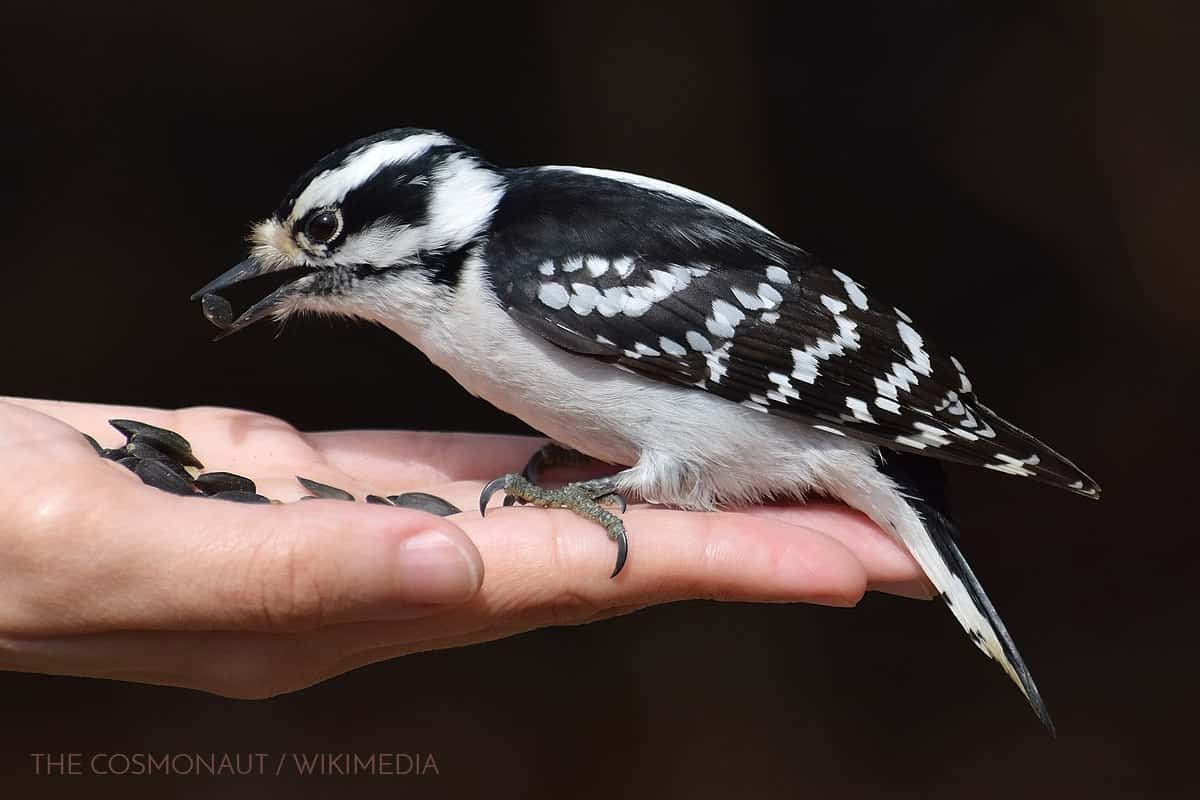
Sunflower Seed
Sunflower seed, that staple of feeding stations across North America, is accepted by a wide variety of woodpecker species, but perhaps most frequently by downy and red-bellied woodpeckers. Lacking the ability to crack seeds in their bills, like finches, or by hammering them between their toes, like jays and chickadees, woodpeckers are forced to take seeds to a nearby crevice, wedge them in, and pound them open.
This can be a time-consuming proposition for a woodpecker. Hulled sunflower seeds, although expensive, are readily accepted by woodpeckers, as well as any other bird that likes seed. Failing that, most woodpeckers gladly switch to suet and peanuts as soon as they are offered.

Fruit and Nectar
Woodpeckers readily eat fruits and drink nectar from flowers and feeders. Halved sections of any citrus fruit or melon are eagerly eaten by woodpeckers, especially in southern locales. Grapes, raisins, apples, bananas, and other fruits will also be consumed. These may be offered on a platform or from a hardware cloth suet feeder. To make it easier for woodpeckers to get at nectar, offer it in a shallow dish on a platform feeder.
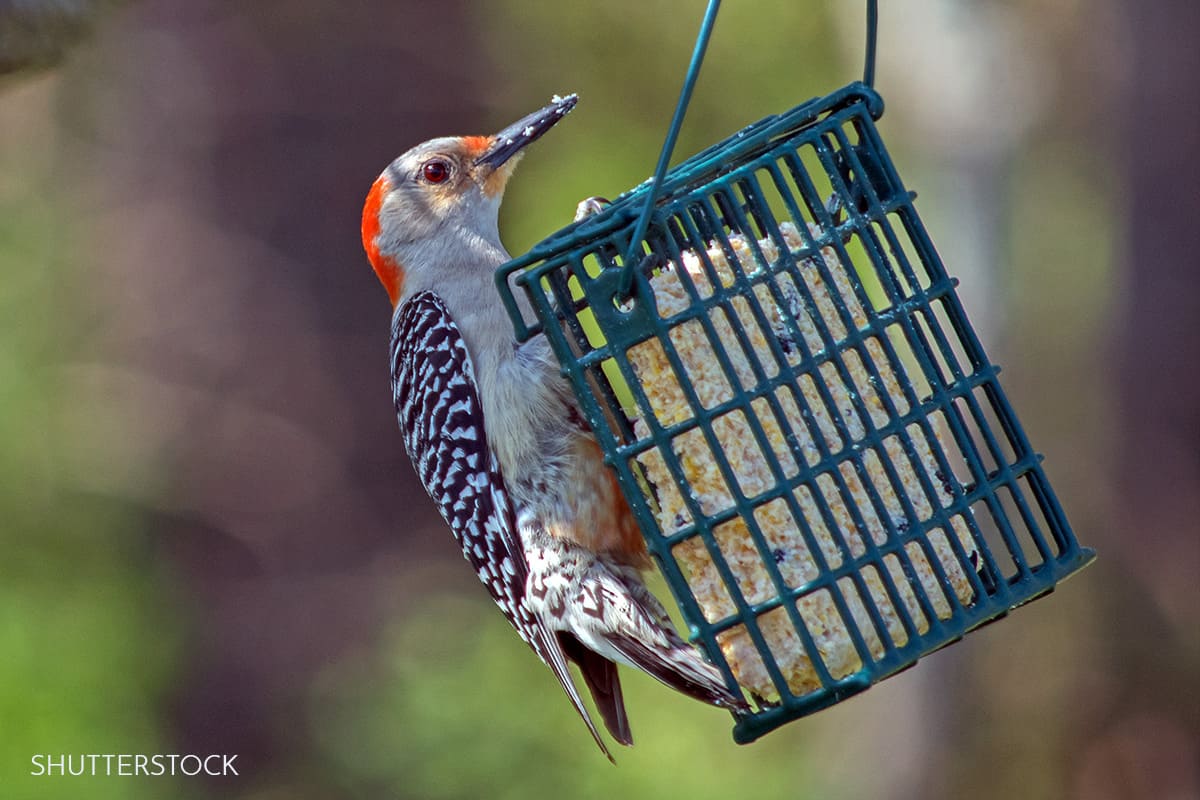
A Note on Woodpecker Feeders
Being adaptable, agile birds, woodpeckers are not picky about the types of feeders they accept; in fact, they’re able to negotiate just about any type, from globe to tube, platform to hopper. They feel most comfortable, however, if they’re able to cling vertically to the feeder; hence you will see them selecting food from cylindrical feeders, or those that are affixed to upright supports, such as posts or trees. Some suet feeders are designed with tail props to accommodate woodpeckers’ stiff, supporting tail feathers, and such feeders are especially attractive to pileateds.
The need for keeping our suet feeder away from the reaching fingers of raccoons has forced us to suspend it from a thin, cast-iron shepherd’s crook in the middle of our lawn; it swings freely, and would seem to be a tough place to perch, but downy, hairy, and red-bellied woodpeckers fly right to it, merrily swinging and twirling as they fill their crops with fat.

